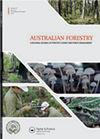Efficiency of micronutrients and sodium use of a Eucalyptus clone as a function of planting density in short-rotation cropping
IF 1.2
4区 农林科学
Q3 FORESTRY
引用次数: 1
Abstract
ABSTRACT The objective of this study was to assess the effect of planting density on the concentration, amount per hectare and nutrient-use efficiency (NUE) of micronutrients (boron – B, copper – Cu, Fe– iron, manganese – Mn, and zinc – Zn) and sodium (Na) of a Eucalyptus grandis × Eucalyptus urophylla clone planted in a systematic experimental design in the coastal region of the state of Rio Grande do Norte, Brazil. The experimental treatments encompassed ten planting densities from 606 to 2564 trees ha-1, with three replicates per treatment. Thirty-six months after planting, the trees were harvested and the concentration (mg kg-1), amount per hectare (kg ha-1), and NUE of micronutrients and Na were evaluated for each tree component (bark, branches, leaves and wood). Regression models were fitted for bark, branches, leaves and wood as a function of growing space. Linear, quadratic, exponential and logarithmic models were fitted. The increase in planting density brought the following results: increases in the concentration of B in leaves, Mn in bark and Na in leaves and bark; decreases in the concentration of Cu in branches and wood; increases in the export of micronutrients per area; increases in the NUE of B and Cu in branches; and decreases in the NUE of Mn for wood, Zn for bark and Na for leaves and bark. There was no significant effect of planting density on the concentration of Fe and Zn. Initial planting density affected the concentration (except Fe and Zn), amount exported per hectare and NUE (except Fe) of micronutrients and Na, but the degree and trend varied according to plant part (e.g. leaves, branches) and elements under study. The harvest of wood only or wood + bark combined with the reincorporation of leaves and branches in the soil show strong potential for returning the micronutrients to the planting site, especially B and Mn.短轮作桉树无性系微量元素和钠利用效率与种植密度的关系
摘要本研究采用系统试验设计,在巴西北部大州(里约热内卢)沿海地区研究了不同种植密度对大桉×尾叶桉无性系微量元素(硼- B、铜- Cu、铁-铁、锰- Mn、锌- Zn)和钠(Na)浓度、每公顷用量和养分利用效率的影响。试验处理的种植密度为606 ~ 2564株/ m2,每处理3个重复。种植36个月后采伐,测定各树种(树皮、树枝、树叶和木材)微量元素和钠的浓度(mg kg-1)、每公顷用量(kg ha-1)和氮肥利用率。回归模型拟合树皮、树枝、树叶和木材作为生长空间的函数。拟合了线性、二次、指数和对数模型。随着种植密度的增加,叶片中B、树皮中Mn、叶片和树皮中Na的浓度均有所增加;枝条和木材中Cu的浓度降低;增加每个地区微量营养素的出口;枝条中B、Cu氮素利用效率增加;木材中Mn、树皮中Zn、叶和树皮中Na的氮素利用效率降低。种植密度对铁、锌含量无显著影响。初始种植密度影响微量元素和Na的浓度(除Fe和Zn外)、每公顷出口量和NUE(除Fe外),但影响程度和趋势因植物部位(如叶、枝)和所研究元素而异。单独采伐木材或木材+树皮,再加上树叶和树枝在土壤中的重新整合,显示出将微量营养元素返回到种植场地的强大潜力,特别是B和Mn。
本文章由计算机程序翻译,如有差异,请以英文原文为准。
求助全文
约1分钟内获得全文
求助全文
来源期刊

Australian Forestry
FORESTRY-
CiteScore
3.70
自引率
4.80%
发文量
15
审稿时长
>12 weeks
期刊介绍:
Australian Forestry is published by Taylor & Francis for the Institute of Foresters of Australia (IFA) for scientific, technical, and professional communication relating to forestry in the Asia Pacific.
 求助内容:
求助内容: 应助结果提醒方式:
应助结果提醒方式:


